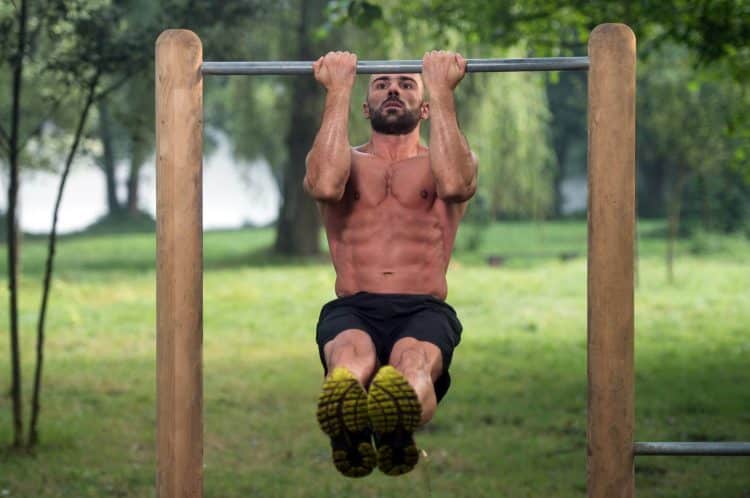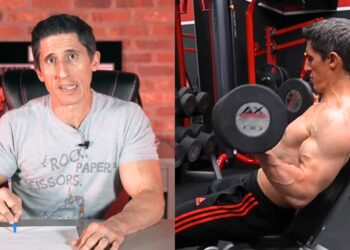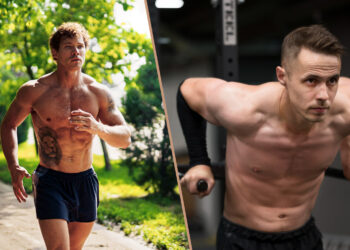There isn’t an exerciser alive who doesn’t want stronger, better-shaped, more attractive arms. Even if you don’t aspire to bodybuilder-sized biceps, better-looking arms are right up there with other fitness must-haves, like a six-pack and a toned butt.
For most people, biceps training means breaking out the dumbbells and barbells and cranking out the curls. However, that’s not the only way to build the arms of your dreams. In fact, you can achieve great results using calisthenics or bodyweight exercises.
In this article, we reveal the best calisthenics biceps exercises and provide you with a simple yet effective workout to follow.
A Brief Introduction to Calisthenics
In its simplest form, calisthenics means bodyweight training. Popular calisthenic exercises include push-ups, pull-ups, crunches, planks, and unweighted squats and lunges.
The word itself comes from the Greek for beauty and strength – kallos and sthenos. Combining kallos and sthenos makes “kalisthenes,” which we anglicize into the more familiar calisthenics.
Calisthenics is a popular workout method that can be used on its own or in conjunction with other training methods, such as resistance bands or free weights. You can use calisthenics to train for almost any fitness goal, including burning fat, general fitness, building muscle, or increasing strength. Your results will depend on which exercises you perform, how you arrange them into a workout, and how often you train.
Level Up Your Fitness: Join our 💪 strong community in Fitness Volt Newsletter. Get daily inspiration, expert-backed workouts, nutrition tips, the latest in strength sports, and the support you need to reach your goals. Subscribe for free!
The benefits of calisthenics include:
1. Convenience
One of the biggest advantages of calisthenics over other forms of strength training is that you can do many of the best exercises anywhere and anytime. You don’t need much equipment, so you can train anywhere you find a few yards of clear space. Few workouts are as convenient as calisthenics, making it an ideal training method for anyone who struggles to work out consistently.
2. Low cost
Gym memberships can be expensive, and many gyms require long-term contracts that are hard to break. As such, you could find yourself paying for a gym you no longer use.
In contrast, most calisthenic exercises are free, and any equipment you do need is pretty cheap. So, as well as being good for your body, calisthenics training is good for your bank balance, too.
3. Low-risk and joint-friendly
While conventional strength training is generally pretty safe, it’s not entirely without risk. For example, you could get stuck under a heavy weight when bench pressing or squatting, which could cause severe injury. There are no such risks with calisthenics, and you can train to failure safely even if you are alone.
In addition, most calisthenic exercises can be adapted to suit your height, weight, and limb length. For example, you can move your hands or feet in or outward to make your chosen exercise more comfortable. This all adds up to safe, joint-friendly workouts.
4. Suitable for all fitness levels
Some calisthenics movements are only suitable for experts, such as muscle-ups and pistol squats. However, there are many more that are ideal for beginner and intermediate exercisers. Many of those exercises can be modified to suit all fitness levels.
For example, you can do push-ups with your hands on a countertop to make them easier or put your feet on the same countertop to make them much harder. You can also use these modifications as a way to progress your workouts, moving from one level to the next as you become stronger.
5. Good for developing a high level of all-around fitness
Bodyweight calisthenic exercises aren’t just good for your muscles – they’re very beneficial for other components of fitness, too. Additional benefits of calisthenics include:
- Improved balance.
- Better coordination.
- Increased mobility and flexibility.
- Improved core strength.
- Better posture.
- Increased athleticism.
- Improved proprioception.
No matter what muscle group you are targeting, calisthenic exercises involve your entire body, which adds to the beneficial effects of this type of training.
Biceps Anatomy Basics
You don’t need a degree in functional anatomy to build show-stopping biceps. That said, knowing a little more about how this muscle works may help you choose the best exercises and workouts to develop it.
The full name of the biceps is biceps brachii. This means two-headed arm muscle, referring to how the biceps comprise two distinct parts, which are commonly called heads.
The biceps (never bicep) have two origins or uppermost attachment sites. The short head originates on the scapula or shoulder blade, while the long head originates just above the shoulder joint. These two attachments come together to form a single muscle belly, which, via your biceps tendon, inserts onto the radius, which is the largest of your forearm bones.
The biceps have three main functions:
- Flexion of the elbow – bending your arm
- Supination of the forearm – turning your palm upwards
- Flexion of the shoulder – raising your arm forward
The biceps are a biarticular muscle, which means it crosses two joints – the shoulder and the elbow. As such, the biceps affect both of these joints, although its effect on the shoulder is relatively weak.
In terms of muscle shape, the short head of the biceps gives your arms their height or peak, while the long head contributes to their thickness. While it is possible to emphasize each head by adjusting the angle of your arm relative to your torso, both heads work together, and it is impossible to isolate one from the other.
The Best Calisthenic Biceps Exercises
So, you want to pump up your guns with bodyweight training? We hear you! These are the best calisthenic biceps exercises for bigger, stronger arms.
1. Chin-ups
While chin-ups are usually thought of as a back exercise, they’re actually a superb biceps builder. Like barbell curls, this exercise involves powerfully bending your elbows against a heavy load. However, instead of curling the bar up to your shoulders, you pull your shoulders up to the bar. The supinated or palms-up grip makes this a very biceps-centric exercise.
Steps:
- Hang from an overhead bar with an underhand, slightly narrower than shoulder-width grip. Pull your shoulders down and back, and brace your core.
- Without kicking or swinging, bend your arms and pull your chin up and over the bar.
- Lower under control and repeat.
Tips:
- Avoid kicking or kipping with your legs, which takes tension off the target muscles.
- Make this exercise harder by wearing a weighted vest or hanging a weight around your waist.
- Make this exercise easier by using a resistance band for assistance.
2. Supinated grip inverted rows
If chin-ups are a little too demanding for you right now, maybe because you are a beginner or on the heavier side, this exercise is a good alternative. While the arm action is very similar, your feet remain on the floor, so there is less weight to lift. Use this exercise to build the strength you need to crank out chin-ups.
Steps:
- Sit below a waist-high bar, such as a barbell in a squat rack or Smith machine, or a portable dip bar, e.g., a Lebert Equalizer.
- Reach up and hold the bar with an underhand, slightly narrower than shoulder-width grip.
- Lean back so your body forms a straight line and your arms are extended.
- Keeping your body straight, bend your arms and pull your chest up to the bar.
- Lower yourself back down smoothly and repeat.
Tips:
- Make this exercise more biceps-centric by curling rather than rowing your body up to the bar.
- Use a higher bar to make this exercise easier, or raise your feet to make it more demanding.
- Try using a false or thumbless grip to increase biceps engagement.
3. Towel pull-ups
Towel pull-ups work your biceps in much the same way as dumbbell hammer curls. As well as hitting your biceps, this move also works your brachialis and brachioradialis, which can add a lot to the shape and size of your upper arms. As an added benefit, this exercise will help strengthen your grip and build your forearms. Popeye had better look out!
Steps:
- Hang two towels over your pull-up bar.
- Clench the ends of each towel together, one in each hand, and hang with your arms straight and shoulders back and down. Brace your core.
- Keeping your hands neutral or facing inward, bend your elbows and pull your shoulders to your hands.
- Lower under control and repeat.
Tips:
- Clench your hands as hard as possible to secure your grip and maximize muscle engagement.
- Drive your elbows down and back for the best biceps-building results.
- You can also do this exercise with a single towel.
4. Commando pull-ups
While it’s unclear why commando pull-ups are so-called, this exercise is a great way to build your biceps while emphasizing one arm at a time. The staggered grip means you can overload each arm in turn, making them a little more challenging than regular pull-ups and chin-ups. This exercise, like towel pull-ups, also hits the brachialis and brachioradialis.
Steps:
- Stand sideways under your pull-up bar. Grip the bar with one hand slightly in front of the other. Hang with your arms straight, core braced, and shoulders down and back.
- Bend your arms and pull your head up to one side of the bar.
- Extend your arms and then pull up to the other side.
- Continue alternating sides for the duration of your set.
Tips:
- Use gym chalk to stop your hands from slipping.
- Switch hand positions set by set to develop both arms equally.
- Wear a weighted vest to make this exercise more challenging.
5. Flexed arm hang
The flexed arm hang is an isometric or static contraction exercise. This means your muscles generate force without changing length. Isometric exercises are very joint-friendly and ideal for anyone who is unable to lift their own body weight with just their arms, as you are stronger isometrically than you are concentrically.
Steps:
- Place a step or bench beneath your pull-up bar. Stand on it and grip your bar with an underhand, slightly closer than shoulder-width grip. Pull your shoulders down and back, and brace your core.
- Keeping your elbows bent and biceps contracted, lift your feet off your platform and hold that position for as long as possible.
- Put your feet back on your platform, rest a moment, and repeat.
Tips:
- Adjust your grip width for comfort and what feels best for your biceps.
- Lock off in different positions to hit your biceps from various angles.
- Finish your hold with a low eccentric descent to finish off your biceps.
6. Suspension trainer biceps curls
Suspension trainers such as the TRX have revolutionized calisthenic training. These adjustable straps allow you to replicate almost any gym exercise using just your body weight for resistance. Suspension trainer curls hit your biceps much like preacher curls, which are a proven arm-building exercise.
Steps:
Level Up Your Fitness: Join our 💪 strong community in Fitness Volt Newsletter. Get daily inspiration, expert-backed workouts, nutrition tips, the latest in strength sports, and the support you need to reach your goals. Subscribe for free!
- Attach your suspension trainer to a high anchor point and take a handle in each hand. Then, lean back and extend your arms. This is your starting position.
- Keeping your body straight, bend your arms and curl your body forward and your chin up to your hands.
- Straighten your arms and repeat.
Tips:
- The longer the straps and the more you lean back, the harder this exercise becomes.
- Use a split stance and use your legs for assistance if required.
- Keep your elbows up and flex your wrists toward your face to maximize biceps engagement.
7. Isometric towel curl
While this isn’t strictly a calisthenic exercise, the minimal equipment requirements mean it’s every bit as accessible and convenient. The great thing about this biceps exercise is that your body weight is not a factor, so it’s ideal for beginners, heavier exercisers, and using when your biceps are already tired.
Steps:
- Fold or roll a towel to make it easier to grip.
- Kneel on the middle of your towel and hold one end in each hand.
- Bend your elbows and attempt to curl your hands upward. Try as hard as possible to bend your arms.
- Keep flexing until your biceps begin to fatigue.
Tips:
- The harder you contract your arms, the shorter your set will be.
- Do not hold your breath during this exercise, as doing so may elevate your blood pressure.
- You can do this exercise standing if you have a long enough towel.
8. Self-resisted curl
The self-resisted curl pits your biceps against your triceps. With this exercise, you use opposing muscle power to get a great biceps workout. Like towel curls, this exercise is not dependent on your body weight for resistance. However, it does allow you to move, making it somewhat of a more conventional biceps exercise.
Steps:
- Stand with your feet shoulder-width apart. With your left arm by your side, reach across with your right arm and clasp your hands together.
- Pushing down with your right arm, bend your left elbow and curl your hands toward your shoulder.
- Use your right arm to push your left hand back down and repeat.
- Swap sides to work the biceps of your opposite arm.
Tips:
- You can also do this exercise isometrically or statically.
- Use this exercise to pump up your biceps to make them temporarily bigger, e.g., before taking a photograph.
- Flex your wrist upward to maximize biceps engagement and also work your forearms.
9. Biceps push-up
Push-ups are, quite rightly, usually considered to be a chest, shoulder, and triceps exercise. However, because the triceps are involved in shoulder extension, it is possible to hit them with push-ups. However, it’s worth noting any push-up variation won’t build your biceps like pulling exercises can.
Steps:
- Lie on the floor on your front. Place your hands flat on the floor in line with your belly button. Your fingers point backward.
- Extend your arms and adopt the classic push-up position.
- Bend your arms and lower your chest to the floor. Your elbows should travel backward.
- Return to the starting position and repeat.
Tips:
- Make this exercise more comfortable by using push-up handles. This will save you from hyperextending your wrists.
- This exercise can be hard on your shoulders, so perform it with care if you have a history of shoulder pain.
- Adjust the angle and position of your hands for comfort.
10. Doorway curls
While close grip inverted rows are an excellent biceps exercise, not everyone has a portable dip bar or Smith machine to do them. This variation only requires a doorframe, making it accessible for all. Do this exercise for high reps for best results, as it’s not particularly challenging.
Steps:
- Stand facing a door frame and grab each side with a waist-high neutral (palms facing in) grip. Place your feet on either side of the door frame.
- Sit back so your legs are bent, and your arms are straight.
- Bend your arms and pull your chest into the doorframe.
- Extend your arms and repeat.
Tips:
- Only use a strong doorframe, as you may damage it while doing this exercise.
- Move your feet further forward to put more weight on your arms.
- No doorframe? You can replicate this exercise with a handrail or sturdy pole.
11. Pelican curl
The pelican curl is traditionally done using gymnastic rings, but you could also use a suspension trainer. This is arguably one of the most demanding exercises around, and it’s tough on your shoulders. It’s a bodyweight version of Bayesian curls, which is a unique and effective biceps cable exercise.
Steps:
- Set your rings to about waist height and stand between them. Hold the with an overhand grip (palms facing away) grip. Brace your core and pull your shoulders back and down.
- Lean forward and hang from the rings with your arms fully extended behind you.
- Bend your elbows to curl your chest towards the rings. Keep your upper arms close to your sides as you move. Squeeze your biceps at the top.
- Slowly extend your elbows and return to the starting position.
- Continue for the desired number of reps.
Tips:
- Warm up your shoulders thoroughly before attempting this exercise.
- Use a staggered stance to take some weight off your arms if necessary.
- The further you move your feet back and angle your body forward, the harder this exercise becomes.
12. Behind-the-neck chin-up
Chin-ups were our first biceps calisthenic exercise, so it’s fitting that we end our list with a chin-up variation. This intense bodyweight biceps exercise will challenge even the strongest calisthenics practitioner and can be tough on your shoulders. But if you can do it, you’ll be rewarded with a great biceps workout.
Steps:
- Hang from an overhead bar with an underhand, slightly narrower than shoulder-width grip. Pull your shoulders down and back, and brace your core.
- Keeping your body straight, bend your arms and pull the back of your neck up to the bar. Imagine you are curling rather than pulling yourself up.
- Extend your arms and repeat.
Tips:
- Make this exercise easier by using a resistance band for assistance. Alternatively, you can use a counterbalance chin-up/dip machine.
- Avoid kicking or kipping with your legs, which takes tension off the target muscles.
- Make this exercise harder by wearing a weighted vest or hanging a weight around your waist.
Calisthenics Biceps Workout
While any of these exercises could help you build more muscular biceps, you’ll get better results if you follow a dedicated, structured workout. Like they say in the military, failing to plan means planning to fail!
So, do this workout 1-2 times a week as part of a body part split routine, where you train different muscles on different days, e.g.:
| Monday | Tuesday | Wednesday | Thursday | Friday | Saturday | Sunday |
| Chest | Back | Legs | Shoulders | Biceps | Triceps | Rest |
But, before you begin, get your body ready for what you’re about to do with a thorough warm-up. Begin with a few minutes of light cardio followed by dynamic mobility and flexibility exercises for your shoulders, elbows, and upper back.
Ready to train? Then let’s go!
Please note: Repetitions are listed for illustrative purposes only. Depending on your current strength and fitness, do as many reps as you can, stopping 1-3 reps short of failure. Try to gradually do more reps as you get stronger.
| # | Exercise | Sets | Reps | Recovery |
| 1 | Chin-ups | 2-4 | 12-20 | 60-90 seconds |
| 2 | Supinated grip inverted rows | 2-4 | 12-20 | 60-90 seconds |
| 3 | Biceps push-up | 2-4 | 12-20 | 60-90 seconds |
| 4 | Isometric towel curl | 2-4 | 20-40 seconds | 60-90 seconds |
| 5 | Doorway curls | 2-4 | 12-20 | 60-90 seconds |
Read also: Hardcore calisthenics arm workout.
Calisthenic Biceps FAQs
Do you have a question about our calisthenic biceps exercises and workout or bodyweight training in general? No problem, because we’ve got the answers!
1. How often should I train my biceps for growth?
Most people do best by training each major muscle group 2-3 times per week. This provides a good balance between training, rest, and recovery. However, because your biceps are involved in most back exercises, you should take care not to overtrain your arms, which would affect your gains.
As such, you may not need to train them as often, and one direct biceps workout per week may be enough. Try different training frequencies to see what works best for you.
2. Can you really build muscle with calisthenics?
Your body is amazing. It can lift heavy weights, run long distances, and perform feats of gymnastics, all while automatically regulating your temperature and heart rate. However, as clever as your body is, it cannot easily distinguish between lifting a heavy barbell, using a resistance training machine, or doing chin-ups for your biceps.
Provided that you work hard and consistently enough, your muscles will adapt to whatever exercises you do, including calisthenics.
So, long answer short, yes – you CAN build muscle with calisthenics.
3. Can I change any of the exercises in the calisthenic biceps workout?
You certainly can! We’ve listed 12 great bodyweight biceps exercises in this article, but only used five for the workout. That leaves seven additional exercises for you to choose from. So, feel free to make changes to customize the workout for your needs, goals, and fitness level.
However, try to resist the temptation to change exercises you find hard. After all, it’s those exercises that will produce the greatest strength and muscle mass gains. Easy workouts don’t build muscle.
4. Does it matter how many reps I do to build muscle?
It’s often said that you need to train in the 6-12 rep range to build muscle. This is the so-called hypertrophy training zone. However, studies suggest you can build muscle with much higher reps – 30 or more – and still trigger muscle growth (1). However, the proviso is that you MUST take your sets to within a couple of reps of failure.
This is good news for bodyweight fans who often have to resort to high reps to fatigue their muscles.
5. What is the best diet for successful calisthenics?
There is no official calisthenics diet, so instead, you should align your diet to your training goal. In other words, create a calorie surplus and consume more protein to build muscle, or lower your calorie, carbohydrate, and fat intake to lose fat.
In other words, the best diet for calisthenics is the one that matches your fitness goal and that you can stick to. Quick-fix fad diets are not the solution!
More on Calisthenics:
- The 11 Best FREE Calisthenics Programs
- Best Calisthenics Triceps Exercises
- Hardcore Calisthenics Arm Workout To Build Muscle Mass and Strength
- Calisthenic Shoulder Exercises and Workout
- The Best Calisthenic Leg Workout
- A Routine for Daily Calisthenics Training
- Weighted Calisthenics Best Exercises and Workouts
- Calisthenics Back Workout for Size and Strength
- Savage Calisthenics Abs Workouts For Beast Gains (All Levels)
- Calisthenics Workout Plan: A Beginner’s Guide
Wrapping Up
You are now armed (pun intended) with 12 of the best calisthenics biceps exercises around. Add these movements to your conventional biceps training, or go all calisthenics all the time for an excuse-free arm-building workout.
Not convinced that you can build big arms with calisthenics? You are not alone! However, a quick look at the biceps of elite male gymnasts should be enough to convince you that you can build muscle with bodyweight training.
Combine this biceps workout with our other calisthenics training programs to build the body of your dreams with minimal equipment and without spending a fortune on gym memberships.
References:
1 – Lasevicius T, Ugrinowitsch C, Schoenfeld BJ, Roschel H, Tavares LD, De Souza EO, Laurentino G, Tricoli V. Effects of different intensities of resistance training with equated volume load on muscle strength and hypertrophy. Eur J Sport Sci. 2018 Jul;18(6):772-780. doi: 10.1080/17461391.2018.1450898. Epub 2018 Mar 22. PMID: 29564973.










